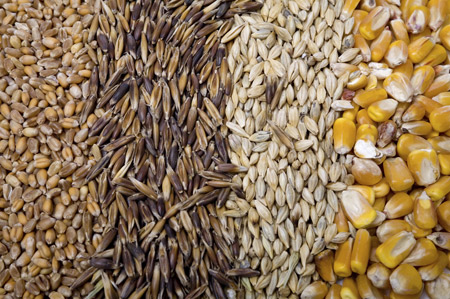 (Agrimoney) – Wheat futures aren’t struggling in all markets.
(Agrimoney) – Wheat futures aren’t struggling in all markets.
In Sydney, the new crop, east coast January 2016 milling wheat contract settled up 1.0% at Aus$303.00 a tonne on Wednesday, its best close in nearly two months, and up 10.6% in the past three weeks, amid EL Nino concerns.
The El Nino, which Australian official forecasters said earlier this week was showing strengthening signs, may well, if history is a guide, bring unduly dry weather to the east coast grains belt.
“There is a sense that perhaps Australia’s east market is worried by crop prospects,” said Tobin Gorey at Commonwealth Bank of Australia.
He also, after talk to farmers, flagged ideas of a “slight drift in planting from wheat into barley”, the latter being a less water-needy crop, but a switch which would of course depress wheat production potential.
‘Overall optimism’
Still, in Chicago, the world benchmark wheat contract was still finding headway difficulty, with market attention focused on potential for northern hemisphere crops nearer to harvesting, and with the heavy rains damaging winter wheat in the southern US Plains not provoking the concerns that many had expected.
The last session’s “trade action in wheat suggests that the market is focused more on the overall optimistic northern hemisphere wheat production outlook than on headline-grabbing excess rains across the US hard red winter wheat belt”, said Richard Feltes at RJ O’Brien.
And prospects for the European harvest are looking up, as attested to by the late-Tuesday report from the official Mars crop unit, while Russian and Ukrainian crops have received upgrades too.
SovEcon was the latest to upgrade its estimate for the Russian grains harvest (largely wheat), to 95m tonnes, from a previous 90.5m tonnes, if down from 105m tonnes a year ago.
‘Will increase abandonment’
Not that the concerns over US wheat have gone away, with more rain in the forecast for areas that now little need it.
Terry Reilly at Chicago-based Futures International said: “Heavy rain battering the southern Great Plains likely will increase the area abandonment projected by the US Department of Agriculture by at least 5%, and lower the quality of the hard red winter wheat crop in many areas across Texas and Oklahoma.
“Wet weather disease and quality issues in the US lower Midwest,” soft red winter wheat country, “will also likely increase this week from wet weather,” Mr Reilly added.
However, while “damage in Oklahoma and Texas was reported due to excessive rains , trade anticipated the excess moisture will aid yields in the areas further north,” CHS Hedging said.
And USDA data overnight showed the condition of the US wheat crop overall holding steady at 45% seen as in “good” or “excellent” condition, a rating Mr Reilly said “shocked” him given the setbacks crops have faced.
Soft red winter wheat for July fell 0.5% to $4.91 ¼ a bushel in Chicago as of 09:30 UK time (03:30 Chicago time), while Kansas City-traded hard red winter wheat for July fell by 0.6% to $5.21 ½ a bushel.
‘Big crop’
The other big ratings figure that traders were looking out for in the USDA data was on corn, with the first condition assessment of the year.
It came in at 74% seen as good or excellent, actually 1 point below market expectations, and a distance from the record figure that some commentators had talked about, but a strong rating nonetheless.
“We look for corn prices to trade lower [in early trading] based on the rating,” Mr Reilly said, forecasting a US harvest in excess of USDA forecasts.
And indeed Chicago corn for July was 0.25 cents lower at $3.54 ¾ a bushel, also little helped by prospects of decent growing weather, with rain less of an issue currently for spring-seeded crops.
“The consensus remains favourable for a big crop moving forward,” said Nicholas Sax at Benson Quinn Commodities.
“A number of analysts are indicating there is potential to add acres and yield to the crop, pending confirmation of forecasted weather.”
Chinese whispers
But soybeans remained resilient, despite the USDA data showing US sowings of the oilseed reaching 61% as of Sunday, bang in line with market expectations, and ahead of the average of 55%.
Concerns over Argentine strikes continue to attract some comment.
And there are some decent demand signals too, with US exports of 291,192 tonnes termed “impressive” by Benson Quinn Commodities, taking the time of year into account, when South American supplies are calling the shots on the world market.
“Shipments will have to average around 153,377 tonnes a week to meet the USDA year-end-estimate” for 2014-15, Mr Sax said, implying the potential for an upgrade to the forecast for US exports of the oilseed this season.
Futures International’s Terry Reilly noted “rumours China bought old crop soybeans, four cargos, over the weekend”, although added that “this could not be verified”.
Soybeans for July stood 0.3% higher at $9.25 a bushel.
Slow plantings
Among soft commodities, cotton futures also extended a gentle recovery, adding 0.1% to 63.37 cents a pound in New York for July delivery.
The USDA crop progress data showed US cotton sowings 47% complete as of Sunday, up 12 points week on week but well behind the average of 61%.
In sodden Texas, the top producing state, just 29% of crop is seeded, compared with as typical 50%.




